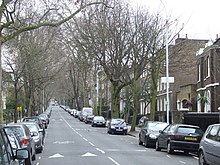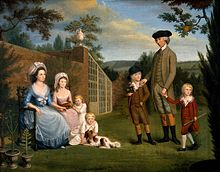Camberwell Grove
 Camberwell Grove in 2010, looking South | |
| Maintained by | Southwark London Borough Council |
|---|---|
| Location | Camberwell, London, England |
| Postal code | SE5 |
| Coordinates | 51°28′09″N 0°05′08″W / 51.46923°N 0.08560°W |
| North end | Camberwell Church Street |
| South end | Grove Hill Road |
| Construction | |
| Construction start | mid-1770s |


Camberwell Grove is a residential street in
Creation
In the mid-1770s, when Camberwell was still a rural village, the dilapidated manor house was demolished and the surrounding land
19th century

John Lettsom, a doctor, had a villa built at the southern end which was demolished when the estate was broken up in the early 1800s, but one of its cottages, 'The Hermitage' (number 220) survives, at the junction with Grove Hill Road.[1] A side-street, Lettsom Street,[b] Lettsom Gardens,[c] a community garden,[5] and a nearby housing estate are named in his honour. The cottage is also Grade II listed.[6][d] A number of other buildings on the street, including Grove Chapel (built 1819, by David R Roper)[7][e] and the Georgian crescent terrace of eight houses forming Grove Crescent,[8][f] are also listed.
The
In 2012, the street was the subject of an episode of the BBC series
20th century
Some of the houses on the grove were damaged by bombing in World War II, and subsequently demolished.[1] The site is now occupied by the flats numbered 100–138.[h]
In the 1960s, a proposal to build an elevated motorway across the grove, above the railway, in the style of the Westway, was opposed and eventually overturned by local residents.[1] The artists David Hepher and his wife Janet bought a house on the grove in 1961, and set up studios there.[1] In 1967 the television producer Jeremy Bennett bought a house there.[1]
Coordinates
- ^ Numbers 79-85: 51°28′17″N 0°05′13″W / 51.47142°N 0.08708°W
- ^ Junction with Lettsom Street: 51°28′12″N 0°05′10″W / 51.47008°N 0.08619°W
- ^ The Hermitage: 51°28′00″N 0°04′53″W / 51.46659°N 0.08140°W
- ^ The Hermitage: 51°27′57″N 0°04′59″W / 51.46577°N 0.08314°W
- ^ Grove Chapel: 51°28′10″N 0°05′11″W / 51.46945°N 0.08637°W
- ^ Grove Crescent: 51°28′06″N 0°05′03″W / 51.46822°N 0.08430°W
- ^ Rail line: 51°28′09″N 0°05′08″W / 51.46914°N 0.08554°W
- ^ Flats, 100–138: 51°28′08″N 0°05′08″W / 51.46876°N 0.08563°W
References
- ^ a b c d e f g h "Camberwell Grove". The Secret History of Our Streets. Episode 2. 13 June 2012. BBC. Retrieved 30 September 2013.
- Southwark Council. Archived from the originalon 7 October 2013. Retrieved 5 October 2013.
- ^ Historic England. "Details from listed building database (1378414)". National Heritage List for England. Retrieved 5 October 2013.
- ^ ISBN 9781849904506.
- ^ "History". Lettsom Gardens Association. Archived from the original on 26 February 2020. Retrieved 6 December 2020.
- ^ Historic England. "Details from listed building database (1378433)". National Heritage List for England. Retrieved 5 October 2013.
- ^ Historic England. "Details from listed building database (1378434)". National Heritage List for England. Retrieved 5 October 2013.
- ^ Historic England. "Details from listed building database (1378426)". National Heritage List for England. Retrieved 5 October 2013.
External links
![]() Media related to Camberwell Grove at Wikimedia Commons
Media related to Camberwell Grove at Wikimedia Commons
